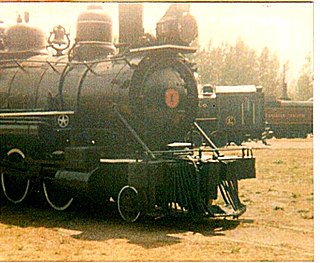Related Research Articles

Caryville is a town in Washington County, Florida, United States located along the Choctawhatchee River. The population was 411 at the 2010 census.

In woodworking, hewing is the process of converting a log from its rounded natural form into lumber (timber) with more or less flat surfaces using primarily an axe. It is an ancient method, and before the advent of the industrial-era type of sawmills, it was a standard way of squaring up wooden beams for timber framing. Today it is still used occasionally for that purpose by anyone who has logs, needs beams, and cannot or would prefer not to pay for finished lumber. Thus, homesteaders on frugal budgets, for example, may hew their own lumber rather than buy it.

A sawmill or lumber mill is a facility where logs are cut into lumber. Modern sawmills use a motorized saw to cut logs lengthwise to make long pieces, and crosswise to length depending on standard or custom sizes. The "portable" sawmill is simple to operate. The log lies flat on a steel bed, and the motorized saw cuts the log horizontally along the length of the bed, by the operator manually pushing the saw. The most basic kind of sawmill consists of a chainsaw and a customized jig, with similar horizontal operation.
The Suwannee Canal was an attempt to drain large portions of the Okefenokee Swamp in Georgia via a canal. The spelling of the Suwannee River has changed over time. The single n variant was more common in the past, but the double n spelling is the standard today.

The Wacissa River is a large, spring-fed stream located in south-central Jefferson County, Florida. Its headwaters are located about a mile south of the town of Wacissa, where the river emerges crystal clear from a group of large limestone springs. From its headsprings, the river flows approximately 12 miles (19 km) south through a broad cypress swamp before breaking into numerous braided channels which join the Aucilla River a few miles further south. The river is managed by the Florida Fish & Wildlife Conservation Commission as part of the Aucilla Wildlife Management Area, and has been declared an Outstanding Florida Waterway by the Florida Department of Environmental Protection.
The Great Southern Lumber Company was chartered in 1902 to harvest and market the virgin longleaf pine forests in southeastern Louisiana and southwestern Mississippi. Bogalusa, Louisiana was developed from the ground up as a company town and was the location for Great Southern Lumber Company's sawmill, which began operation in 1908. Other company interests included a railroad and paper mill. The company ceased operation in 1938, when the supply of virgin pines was depleted. Bogalusa became the site of a paper mill and chemical operations, followed by other industry.
Copeland is an unincorporated community located in eastern Collier County, Florida, United States. It lies at the junction of State Road 29 and Janes Memorial Scenic Drive. Copeland lies along the western border of the Big Cypress National Preserve, and wedged beside the Fakahatchee Strand Preserve State Park to the east. The hamlet of Jerome is a few miles to the north, while Carnestown lies a few miles to the south at the intersection of State Road 29 and U.S. Route 41.
The Finkbine-Guild Lumber Company was established to harvest and market the virgin longleaf pine stands of southern Mississippi during the early 20th century. The main sawmills were located in Wiggins and D'Lo, Mississippi. When the local timber supply dwindled, the company tried to utilize redwood trees from California, but that operation failed because of high transportation costs. Other attempts were made at promoting a more diversified use of the cutover timberlands; some ventures were successful while others were not.

Brooks-Scanlon Corporation No. 1 is a 2-6-2 steam locomotive at Steamtown National Historic Site in Pennsylvania. This type of locomotive is referred to as a Prairie-type locomotive. This locomotive was built specifically for the lumber industry and served several lumber firms in Florida.

Goodwin Heart Pine is a company located in Micanopy, Florida and specializes in reclaiming antique heart pine and heart cypress from rivers and old buildings to produce lumber for flooring, stair parts and millwork. Goodwin's product range also includes other sustainable and rare woods, including wild black cherry. Goodwin Heart Pine also produces precision-engineered wood flooring, from these specialty woods. The company has a unique focus of harvesting resin-saturated deadhead logs from rivers that loggers felled in the 1800s, which sank due to their high resin content. The interior of the reclaimed logs is typically preserved by the tree's resin.
Foshee is an unincorporated community in Escambia County, Alabama, United States between Brewton and Pollard on U.S. Route 29. Foshee was founded as a sawmill town and named after Stewart J. Foshee, who owned several sawmills in Escambia County. Russell A. Alger and Martin Sullivan founded the Alger-Sullivan Lumber Company in the late 1890s and began logging around Foshee. They used lumber from the mill to build a new sawmill in Florida, which eventually grew into the town of Century. A post office was operated in Foshee from 1914 to 1924.
Alden Lake is a freshwater 180-acre lake with 159 (88%) acres of littoral area and a maximum depth of 29 feet located in northern Minnesota 14 miles northeast of Duluth off St. Louis County Highway #44. Alden does not have a developed public access along the shoreline but can be accessed by canoe through the Cloquet River. The primary fish management species are walleye, with secondary management for largemouth bass and smallmouth bass.
Mendocino Lumber Company operated a sawmill on Big River near the town of Mendocino, California. The sawmill began operation in 1853 as the Redwood Lumber Manufacturing Company, and changed ownership several times before cutting its final logs in 1938. The sawmill site became part of the Big River Unit of Mendocino Headlands State Park where a few features of the mill and its associated forest railway are still visible along the longest undeveloped estuary in northern California.
Glenwood is a small unincorporated community in West Volusia County, Florida. It developed as an orange growing agricultural and lumber industry community. It is now home to a trail and a group home residential community. It is popular for birding and borders Lake Woodruff National Wildlife Refuge.

Putnam Lodge is a historic hotel built in 1927 in Dixie County, Florida. Depending on the source it is located in Shamrock, Florida or adjacent Cross City, Florida. It was built in the company town developed around Putnam Lumber Company's operations in Shamrock. The hotel was renovated for a 2014 reopening after being closed for many years.

Brooks-Scanlon Lumber Company was a lumber products company with large sawmills and significant land holdings in Minnesota, Florida, British Columbia, and Central Oregon. The company was formed in 1901 with its headquarters in Minneapolis, Minnesota. Beginning in 1915, its main lumber production facility was in Bend, Oregon. For many years, its Bend sawmill was one of the largest lumber producers in the world. In 1969, the company created Brooks Resources to broaden its business base beyond timber production. Brooks-Scanlon's Bend sawmill was closed in 1994. Today, Brooks Resources is the only vestige of the company that is still in business.

Brooks Resources is a real estate development company with significant land holdings in Central Oregon, United States. The company was formed in 1969 as a subsidiary of Brooks-Scanlon Lumber Company. It became an independent corporation in 1979. Brooks Resources develops residential neighborhoods, vacation rental properties, commercial complexes, and mixed-use communities. The company headquarters is located in Bend, Oregon.
William O'Brien was a steam cargo ship built in 1914–1915 by New York Shipbuilding Company of Camden for the Carpenter–O'Brien Lumber Company of Delaware. The vessel was extensively employed on East Coast to Europe routes during her career and foundered on one of her regular trips in April 1920.
SS Jerry S. Foley was a Liberty ship built in the United States during World War II. She was named after Jerry S. Foley a prominent businessman in Jacksonville, Florida. Foley was the president of the Brooks-Scanlon Lumber Company, in Foley, Florida; on the board of directors of the Atlantic National Bank, in Jacksonville; president of the Bahamas-Cuban Co.; and president of the LOP&G Railroad.
Foley is an unincorporated area in Taylor County, Florida, United States. It is located about 5 mi (8.05 km) southeast of Perry. The area is named after Jerry S. Foley, who founded it as a company town for the Brooks-Scanlon Lumber Company.
References
- ↑ "Carbur". Geographic Names Information System . United States Geological Survey, United States Department of the Interior . Retrieved May 9, 2018.
- ↑ Drobney, Jeffrey A. (22 April 1997). Lumbermen and Log Sawyers: Life, Labor, and Culture in the North Florida Timber Industry, 1830-1930. Mercer University Press. ISBN 9780865545465 – via Google Books.
- 1 2 "Brief History of Taylor County, Florida". The Taylor County Historical Society.
- ↑ Florida, State Library and Archives of. "Search Results". Florida Memory.
- ↑ Florida, State Library and Archives of. "Skidder loading logs at Carbur". Florida Memory.
- ↑ "Florida Health Notes". Health Program Office, Department of Health and Rehabilitative Services, State of Florida. 22 April 2018 – via Google Books.
- ↑ Health, Florida State Board of (22 April 2018). "Annual Report - State Board of Health, State of Florida". State Board of Health. – via Google Books.